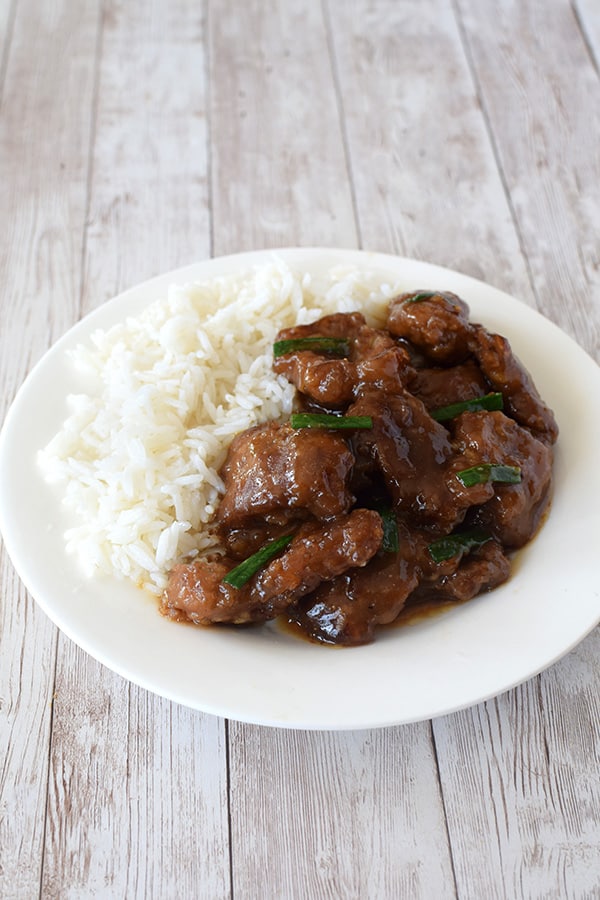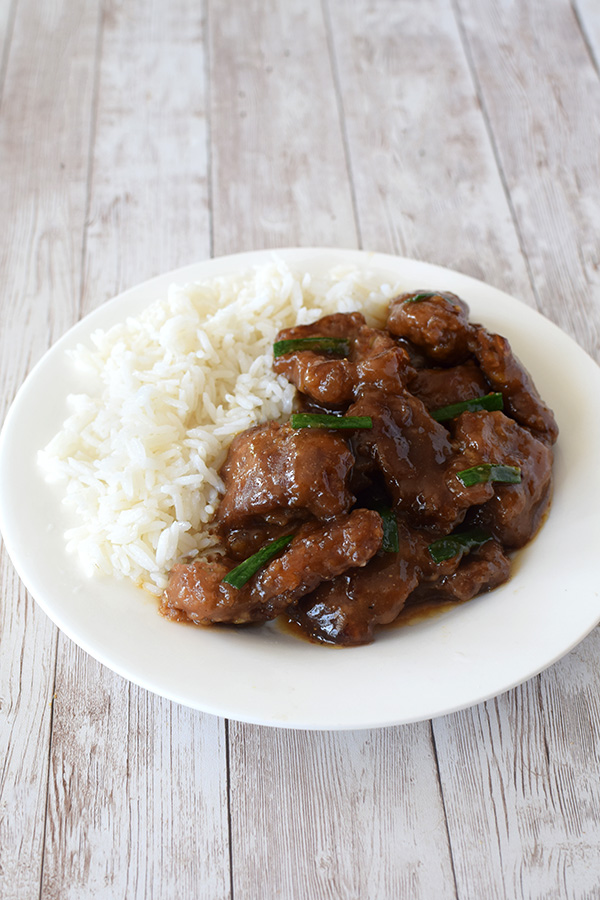Easy Kosher Mongolian Beef is a very simple, dairy free and delicious make-at-home kosher American Chinese dish that is quick to prepare!

No need to go to a restaurant for Kosher American Chinese! Impress your family, your guests, and yourself by making Easy Kosher Mongolian Beef. Perfect anytime!
And did you know that beef has health benefits? Well, it does!
A little of my cooking background
I really wanted to title this blog “If I can make it, anyone can” because, honestly, if I can make it, anyone can.
I never really liked cooking, and when I was single, a meal for me meant grilled cheese, eggs, tuna, or something else that didn’t require effort or time.
When my kids were young, I was still able to get away with preparing only a small variety of easy meals, but the older they got, the more dishes I learned to make at their request.
Still, I insisted on keeping it simple.
Honestly, I never understood why some cooks unnecessarily complicate meals. I have seen recipes that have several ingredients that don’t really seem to add much, if anything, to the dish. So, why bother?
It has always been important to me that whoever eats at my table will have plenty to enjoy, and that includes my kids (I never agreed with the “You will eat what is served or you won’t eat” ideology), and, because I keep it simple, I can prepare a variety of dishes in a relatively short period of time.
I have a philosophy regarding being a great cook: Prepare food according to the tastes of those who will be eating it, and they will love your cooking!
As far as I am concerned, start with the basic ingredients that make the dish what it is, adapt according to taste, and voila! You are an amazing cook!
The bottom line is that while there are certainly delicate recipes out there for specialty dishes, making delicious meals doesn’t have to be complicated or time-consuming. It’s not difficult to impress—just make sure it tastes good.
While some of the recipes on my blog are more time-consuming than others, they are all tried and true easy-shmeezy!
Of course, one always has to consider the conditions under which they cook. Weather (humidity, heat, cold), different types of ovens, different quality of pots, etc.—all of which can affect your cooking and baking.
Nevertheless, as I said, if I can do it, anyone can!
A little about American Chinese Food
American Chinese cuisine is a style of Chinese cuisine that was developed by Chinese Americans. These dishes significantly differ from traditional Chinese dishes, because American-Chinese dishes were adapted to suit American tastes.
Chinese immigrants arrived in the United States in large numbers in the mid 19th century in order to escape the economic difficulties in China, hoping to find work during the California Gold Rush and on the Central Pacific Railroad.
They mostly settled together in ghettos, individually known as Chinatown, and – since there were laws preventing them from owning their own land – they opened their own businesses, such as laundry services and restaurants.
Initially, the family-owned businesses catered to miners and railroad workers and estaurants were set up in places where Chinese food was unknown. Food was based on the requests of the customers and recipes were created to suit American tastes using whatever ingredients were available.
One major difference between traditional Chinese cuisine American-Chinese cuisine is in the use of vegetables. American Chinese recipes will use raw or uncooked ingredients and those not native to China. Traditional Chinese cuisine, on the other hand rarely contain raw or uncooked ingredients and often uses Asian leaf vegetables.
While he new dishes were not traditional Chinese, these restaurants were responsible for the development of the ever-popular American Chinese cuisine.
The little history of Kosher Chinese Food
It is well known that Jews (especially those with ties to New York) love Chinese food. You can find at least one and, more often than not, several kosher Chinese restaurants in predominately Jewish neighborhoods. In the town of Cedarhurst, New York, for example, there are two within a couple of blocks – both excellent…and don’t even get me started on Brooklyn.
There is a popular joke, which has been passed around for many years which describes the Jewish dependency on Chinese food: “According to the Jewish calendar, the year is 5749. According to the Chinese calendar, the year is 4687. That means for 1,062 years, the Jews went without Chinese food.” That was back in 1989 and who knows when the joke even started?
Jews as a group were probably first introduced to Chinese food in the Lower East Side of Manhattan, where immigrants of various cultures settled in their own neighborhoods in the late 1800s and early 1900s.
By the early 1900s, approximately one million Jews from Eastern Europe and half a million Italians from Southern Italy shared the Lower East Side of Manhattan with only approximately 7,000 Cantonese Chinese, most of who had moved from California.
Due to anti-Chinese laws and acts, which prevented them from competing with whites, many Chinese opened restaurants.
The majority Jewish immigrants at that time were observant in their religion and ate only kosher food when they arrived in New York. But, over time, many assimilated and their children, who were less interested in keeping “the old ways” and more interested in other cultural experiences, even more so.
Some continued keeping kosher at home, while allowing themselves to stray while out. Sunday was a favorite time for eating out and Chinese food was not only reasonably priced, but their restaurants were open on Sundays.
Not only that, but Chinese food didn’t use milk and while excuses may be made for eating non-kosher meat outside of the home, there was still the forbidden mixing of meat and milk to consider.
Having been raised with what is forbidden, these Jews seemed to feel that if they couldn’t tell it was non-kosher, it wasn’t that bad (or wasn’t repulsive), even if it contained pork or non-kosher seafood. The attitude seemed to be, if I can’t see it, it won’t kill me.
But what about Jews who did keep kosher? It took decades, but finally one enlightened Jewish, kosher deli owner found a solution. Using Cantonese Chinese recipes and substituting kosher veal, beef, and chicken livers for pork, he began selling the first kosher Chinese food. This was Sol Bernstein, the eldest son of Schmulka Bernstein.
Schmulka Bernstein ran kosher butcher store and smokehouse on the Lower East Side of Manhattan near Essex St for approximately 30 years from the 1930s until the mid-1960s.
In 1959, Sol, opened a delicatessen on Essex Street and called it Bernstein-on-Essex. His slogan was “Where kashrut is king and quality reigns” (kashrut = kosher).
Although the deli was separate from Schmulka’s butcher shop and belonged to Sol, everyone still called it Schmulka Bernstein’s and anyone who is still around and remembers, still does so till this day. In fact, I doubt that many people even know that the deli belonged to Sol or that it was Sol who was the originator of Kosher Chinese food in the US.
Sol continued to sell deli while he incorporated Chinese foods into the menu and did very well. The restaurant continued to prosper until he died in 1992, when it was sold.
Love kosher American Chinese dishes? Try these!
- Easy Kosher Beef and Broccoli
- Easy Kosher Chicken and Broccoli
- Easy Kosher Pepper Steak
- Easy Kosher Mongolian Chicken
- Easy Kosher Corned Beef & Cabbage Egg Rolls
- Easy Kosher Chicken Lo Mein
- Easy Kosher Beef Lo Mein
- Easy Kosher General Tso’s Chicken
- Easy Kosher Chicken Fried Rice
- Easy Vegetarian Fried Rice
- Easy Kosher Chicken Chow Mein
- Easy Kosher Beef Chow Mein
- Easy Egg Drop Soup
Easy Kosher Mongolian Beef

Dairy Free Kosher Mongolian Beef Recipe
Ingredients
- Meat
- 1 pound kosher beef, such as ribeye, sirloin or something that cooks quickly
- 1/2 cup flour or corn starch
- 1/2 tablespoon salt
- 2 green onions, sliced into 1 inch pieces
- 1 teaspoon black pepper (optional)
- Oil for frying
- Sauce
- 3 tablespoons soy sauce
- 1/2 tablespoon brown sugar
- 3/4 teaspoon granulated garlic or 1/2 teaspoon powdered garlic
- 1/2 teaspoon ginger powder
- 1 teaspoon chicken consume powder
- 1/4 cup water
- 1.5 teaspoons pepper flakes (optional)
- 1 teaspoon sesame oil or cooking oil
Instructions
- Slice meat into strips of approximately 1 inch x 1.5 inch strips, 1/4 inch thick (they do not have to be exact).
- Mix together flour or cornflour, salt, and pepper (optional)
- Place pieces of meat in mixture and coat very well.
- Pour oil into a frying pan just to cover the bottom and heat on medium heat.
- Fry coated meat pieces on medium heat until they have browned and are crispy. Do not crowd the pan - fry in batches if necessary. Set aside prepared pieces.
- In a separate frying pan, mix soy sauce, brown sugar, garlic, ginger, chicken consume powder, water, oil, and chili peppers flakes (optional),
- Cook on a medium heat just until the mixture becomes a thick sauce (this should happen fairly quickly).
- Turn off heat.
- Add meat pieces and cut green onions.
- Toss or stir gently until evenly coated.
Notes
To ensure this dish is kosher, make sure that not only the chicken is kosher but that there is no question about any of the other ingredients as well.
Nutrition Information:
Yield:
4Serving Size:
1Amount Per Serving: Calories: 641Total Fat: 38gSaturated Fat: 13gTrans Fat: 1gUnsaturated Fat: 22gCholesterol: 162mgSodium: 1699mgCarbohydrates: 20gFiber: 2gSugar: 3gProtein: 52g